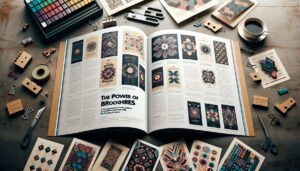In today’s digital age, where online marketing and social media are dominating the advertising landscape, it’s easy to overlook the power of traditional print marketing materials. One such material that often gets overlooked is the humble brochure.
Brochures are a versatile and effective marketing tool that can convey a wealth of information about your business, products, and services in a compact and visually appealing format. They can be distributed at trade shows, events, in-store, or through direct mail campaigns, making them an essential component of any comprehensive marketing strategy.
Why Brochures Matter
Brochures offer a tangible and personal touch that digital marketing can’t quite replicate. When a potential customer holds a well-designed brochure in their hands, they’re able to physically interact with your brand in a way that a website or social media post can’t match. This tactile experience can leave a lasting impression and make your brand more memorable.
Furthermore, brochures allow you to tell your brand story in a way that is both informative and visually engaging. You can showcase your products or services, highlight key features and benefits, and communicate your brand’s values and unique selling points. By presenting this information in a visually appealing and well-organized manner, you can capture your audience’s attention and make a strong impression.
Brochures are also a cost-effective marketing tool. Unlike digital ads that can be easily ignored or scrolled past, a well-designed brochure is more likely to be noticed and kept for future reference. This longevity means that your marketing message will continue to reach your audience long after the initial distribution, maximizing your return on investment.
Designing an Effective Brochure
To harness the full potential of brochures as a marketing tool, it’s essential to invest in professional design and high-quality printing. A well-designed brochure will effectively communicate your brand’s message, capture your audience’s attention, and leave a lasting impression.
When designing your brochure, consider the following key elements:
-
Visuals: Use high-quality images and graphics that are relevant to your brand and visually appealing. Visuals are a powerful tool for capturing your audience’s attention and communicating key information.
-
Content: Keep your messaging clear, concise, and targeted to your audience’s needs and interests. Include information about your products or services, key features and benefits, and a clear call to action.
-
Layout: Organize your content in a logical and easy-to-read layout. Use headings, subheadings, and bullet points to break up text and make it more digestible. Consider the flow of information and guide your audience through the brochure in a way that leads them to take action.
-
Brand Identity: Ensure that your brochure aligns with your brand’s visual identity, including colors, fonts, and logo. Consistent branding helps to reinforce your brand’s message and makes your brochure more memorable.
-
Print Quality: Choose a reputable printing company that uses high-quality materials and printing techniques. A professionally printed brochure will look and feel premium, enhancing your brand’s image and making a stronger impression on your audience.
Distributing Your Brochures
Once you have designed and printed your brochures, the next step is to distribute them strategically to reach your target audience. Consider the following distribution channels:
-
Events and Trade Shows: Distribute brochures at industry events, trade shows, and conferences where you can connect with potential customers and network with industry professionals.
-
In-Store: Display brochures in your storefront or at the point of sale to educate customers about your products or services and encourage them to make a purchase.
-
Direct Mail: Send brochures to targeted mailing lists to reach potential customers in specific geographic areas or demographics.
-
Handouts: Distribute brochures at high-traffic locations such as shopping malls, airports, or community events to reach a wider audience.
By distributing your brochures through a mix of channels, you can maximize your reach and ensure that your marketing message reaches your target audience effectively.
Measuring Success
To evaluate the effectiveness of your brochure campaign, it’s important to track key metrics such as:
-
Response Rate: Measure the number of inquiries, sales, or website visits generated as a result of your brochure distribution.
-
Engagement: Monitor how long recipients spend reading your brochure and which sections they find most engaging.
-
Conversion Rate: Track the number of leads or sales generated from your brochure campaign to assess its impact on your bottom line.
By analyzing these metrics, you can gain valuable insights into the effectiveness of your brochure campaign and make data-driven decisions to optimize your marketing strategy.
In Conclusion
In conclusion, brochures are a versatile and effective marketing tool that should not be overlooked in today’s digital age. They offer a tangible and personal touch that digital marketing can’t replicate, allowing you to tell your brand story in a visually appealing and informative way. By investing in professional design, high-quality printing, and strategic distribution, you can harness the full potential of brochures to reach your target audience, generate leads, and drive sales. So next time you’re planning your marketing strategy, don’t forget to include brochures as a valuable component of your advertising toolkit.



